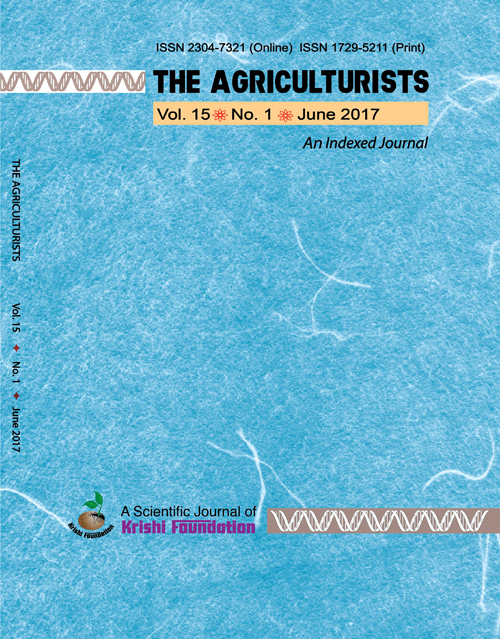Leaf Blight Disease caused by <i>Pseudomonas syringae</i> pv. <i>syringae</i> in the Nurseries of Litchi (<i>Litchi chinensis</i> Sonn.) and its Management
DOI:
https://doi.org/10.3329/agric.v15i1.33424Keywords:
Antibiotic, BAU-Biofungicide, litchi, leaf blight, management.Abstract
Leaf blight of seven varieties of litchi caused by Pseudomonas syringae pv. syringae was surveyed in the nurseries of major litchi growing areas in Bangladesh viz. Rajshahi, Dinajpur, Rangpur, Mymensingh and Khagrachari. The mean level of incidence and severity were 8.58 and 7.88% in Rajshahi, 9.88 and 8.88% in Dinajpur, 8.44 and 7.76% in Rangpur, 6.50 and 6.18% in Mymensingh and 9.00 and 7.98% in Khagrachari. Incidence and severity of bacterial leaf blight disease of litchi varied significantly depending on weather conditions. Correlation studies revealed that bacterial leaf blight disease of litchi seedlings were positively correlated with temperature, rainfall and relative humidity, where temperature and rainfall was the major factor to the variations of both incidence and severity. Antibiotic sensitivity test revealed that among fifteen isolates, most of the isolates of P. syringae pv. syringae collected from litchi were sensitive to Gentamycin and Erythromycin. Under net house condition, six different treatments (i) Gentamycin @ 0.05%, (ii) Erythromycin @ 0.05%, (iii) Doxycycline @ 0.05%,(iv) Copper sulphate @ 0.05%, (v) BAU-Biofungicide @ 2% and (vi) Control were used for controlling bacterial leaf blight of litchi (Variety: China-3). BAU-Biofungicide was found to be superior in controlling bacterial leaf blight of litchi that reduced 33.64% disease incidence and 60.77 % disease severity in 2010-11 and 63.76% disease incidence and 61.40 % disease severity in 2011-12 over control when applied as foliar spray @ 2% followed by Copper sulphate (0.05%) and Erythromycin (0.05%).
The Agriculturists 2017; 15(1) 10-18
Downloads
123
170

